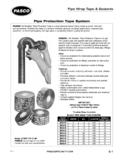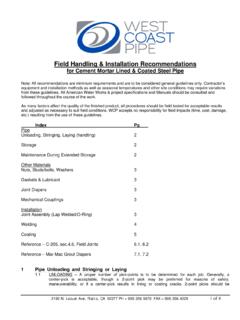Transcription of Fluorescence Procedures for the Actin and Tubulin ...
1 Fluorescence Procedures for the Actin and Tubulin Cytoskeleton in Fixed Cells Actin : Louise Cramer Tubulin : Arshad Desai General Strategy We typically work with tissue culture, primary mammalian cells, and cell extracts, but the protocols can be adapted to other systems, such as whole embryos or lower eukaryotes. The cytoskeleton is very dynamic and sensitive to changes in both the chemical and mechanical environment. Optimal conditions for Fluorescence of proteins of the Actin and Tubulin cytoskeleton are based on: preserving cell structure; properties of individual cytoskeletal proteins and any antibodies to be used; background Fluorescence . Buffers, fixes and detergents can dramatically affect cell preservation , and some antibodies will only bind antigen under specific fixation conditions.
2 There is often quite a high level of Actin monomer, Tubulin subunits and cytoskeletal binding proteins free in the cytoplasm, especially in tissue culture cells. This can reduce the resolution of cytoskeletal polymers and makes it difficult to analyze the detailed localization of polymer binding proteins. To overcome this cells can be briefly extracted (seconds) before fixing under conditions that stabilize Actin filaments or microtubules and preserve cell structure. This selectively removes free subunits/unbound binding proteins from the cytoplasm without causing significant changes in polymeric structure. Growing Cells for Immunofluorescence We plate cells on glass coverslips (12mm circles or similar ). We pretreat coverslips typically with poly-L-lysine (PLL) if cells are loosely adherent to glass.
3 Polyornithine is better for some neurons. Cells can also be grown in a commercial, removable chamber attached to a plastic coverslip. Preparing Glass Coverslips Acid wash coverslips. This helps cells and polyamino acids stick to glass. 1. Heat coverslips in a loosely covered glass beaker in 1M HCl at 50-60oC for 4-16h. 2. Cool. 3. Wash coverslips extensively in dH2O, then ddH20. 4. Rinse coverslips in ethanol and leave to dry between a folded sheet of whatman paper (dry as separate coverslips). 5. Keep in a sterile tissue culture dish (can store for a year). Coat with polyamino acid. 1. Coat coverslips in bulk in 10-15ml 1mg/ml PLL (or 500ug/ml polyornithine), rocking or rotating for a minimum of 30 minutes in a 10 or 15cm tissue culture dish.
4 2. Save the polyamino acid (can reuse 3-4 times). 3. Wash the coverslips in dH2O, then ddH20 at least 5 changes in each (free polyaminoacid is cytotoxic). 4. Rinse coverslips in 100% ethanol and dry those to be used immediately on one end in an open tissue culture dish in a sterile incubator. 5. When dry, add cells. 6. Dry remaining coverslips between a folded sheet of whatman paper (dry as separate coverslips). 7. Keep in a sterile tissue culture dish (can store for a year). Do step 4 before use. Can keep 10-20ml aliquots of 1mg/ml PLL and 500ug/ml polyornithine stocks at -20 deg C. High molecular weight PLL is standard (greater than 300K), but lower molecular weight PLLs can also be tried. Optional-- Coat polyaminoacid/acid washed/coverslips with matrix molecules.
5 This helps the attachment of very poorly adherent cells ( neurons), and increases the growth rate of other cell types ( primary culture cells). Different extracellular matrix molecules can also change the morphology of certain cell types ( protrusion of lamellipodia or filopodia, flattening of cell bodies useful for microinjection- usually determined empirically). 1. Coat individual polyamino acid/acid washed/coverslips with a drop of specific matrix molecule (held by surface tension) from frozen stocks for a minimum of 30 minutes at room temperature or in a 37 deg C incubator, or overnight at 4 deg C. Examples: --Collagen type IV/PLL/acid washed coverslips PC12 cells (100ug/ml collagen), somites (2mg/ml collagen). --1x matrigel/PLL/acid washed coverslips Primary fibroblasts, neuroblastomas, fibromas, amphibian motor neurons, embryonic dorsal root ganglia.
6 --10ug/ml laminin-polyornithine acid washed coverslips Adult dorsal root ganglia. 2. Wash 5x with calcium and magnesium free PBS, then 1x with culture media. 3. Plate cells. Coverslips must be coated fresh before plating cells. Washed, coated , coverslips can be stored for a maximum of one day in the cold room. Reagents and Buffers BRB80 is good for microtubules and 'cytoskeleton buffer' is good for both Actin filaments and microtubules. The optional inclusion of sucrose keeps the cells isoosmotic which also helps preservation . Brinkley Buffer 1980 (BRB80) 80mM PIPES pH 1mM MgCl2 1mM EGTA Store at 4 deg C; (we generally make and store as a 5X stock) Cytoskeleton Buffer (CB) with sucrose (CBS) 10mM MES pH 138mM KCl 3mM MgCl 2mM EGTA Store at 4 deg C Add sucrose fresh on the day of use of the buffer to final M from 4 deg C stock (78% is 7X).
7 Detergents In general Triton-X-100 (TX) is best, but it can sometimes be too harsh for delicate cells. We standardly use TX at a concentration of , but gentler detergents such as saponin can also be substituted. TWEEN is often used in whole embryos. Make solutions with detergent fresh on the day of use. TBS (For all steps after fixing. ) M NaCl M Tris-Cl pH Can make 10X stocks. Keep at room temperature or 4 C. PBS can be substituted. Antibody Diluting Solution("AbDil"; used to dilute antibody stocks and to preblock cells.) TX 2% BSA Azide Store at 4 deg C Mounting Media: We have had great success with mounting our coverslips in: % p-phenylenediamine (Free Base; purchased from Sigma) in 20 mM Tris, pH , 90 % glycerol We prepare this by adding the p-phenylenediamine to the tris/glycerol and dissolving it by bubbling nitrogen through the tube for 3-4 hours.
8 The mounting medium is stored at -20 deg C. It will turn brown over time and we generally discard once it turns dark brown before making a fresh batch. In our experience, this recipe results in greatest photostability for all the fluorophores we use - rhodamine, fluorescein, Cy5 and DNA binding dyes. Adding Solutions, Washing and Blocking Mechanical manipulations should be kept to a minimum without compromising the quality of the final image. For cells on coverslips, aspirate solutions gently from the side of the dish or coverslip with one hand and add new solutions gently to the other side with your other hand. Never drop solutions directly onto the cells and do not allow cells to dry out. Rinsing cells before fixing does not make much difference.
9 Residual serum proteins from the cell growth media may also help to 'buffer' cells during fixation. Washing off excessive antibodies is crucial for good staining. The block step minimizes background staining. Secondary Antibodies We normally purchase our fluorescently labelled secondary antibodies from Jackson Laboratories. We especially like their anti-IgG antibodies raised in donkey-- these are very clean. We follow their directions for reconstitution and storage. For a working solution, we dilute antibodies (usually 1:50 or 1:200-- you'll have to determine what works for you) in AbDil and store this at 4 deg C. If you notice high bakground, filter through a um syringe filter or spin in a microfuge. Procedures For antibodies that have unknown properties on fixed cells it is best to start with one fixing condition that preserves native structure ( formaldehyde or glutaraldehyde) and one fixing condition that denatures proteins ( methanol or acetone).
10 Simultaneous fixing and permeabilizing also works well for some antibodies. Generally for Actin filaments and the Actin cytoskeleton we prefer methanol over acetone fixation, and formaldehyde over glutaraldehyde fixation. Glutaraldehyde requires a reducing step that can mechanically dislodge any delicate Actin -containing structures ( filopodia, lamellipodia, retraction fibers, growth cones). Fluorescent-phalloidin is commonly used to stain Actin filaments which only binds native Actin . For microtubules and the Tubulin cytoskeleton the choice of fixative depends on whether the object of the experiment is to visualize microtubules alone or to visualize microtubules in addition to your favorite antigen. For microtubules alone, glutaraldehyde fixation after a brief extraction is preferable.








